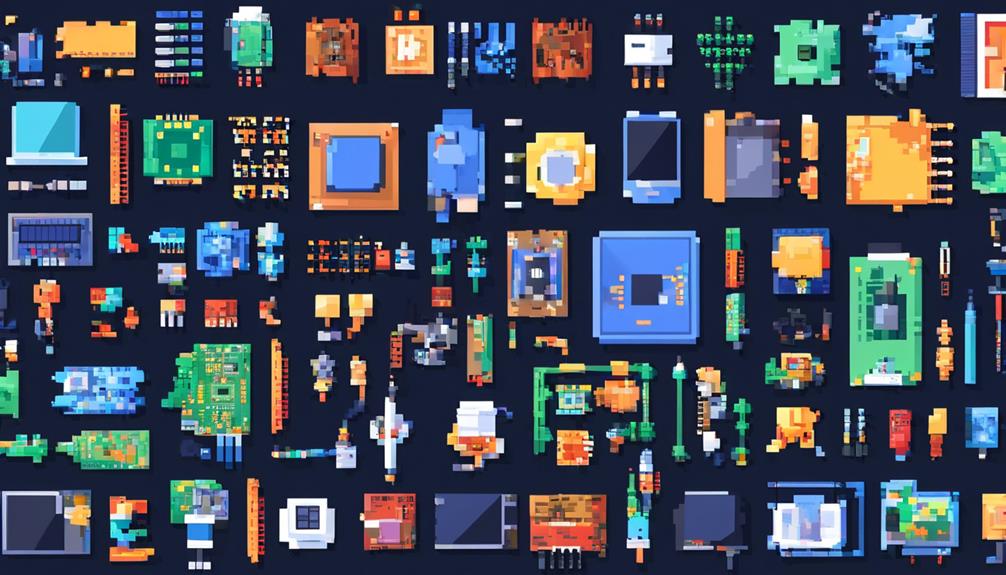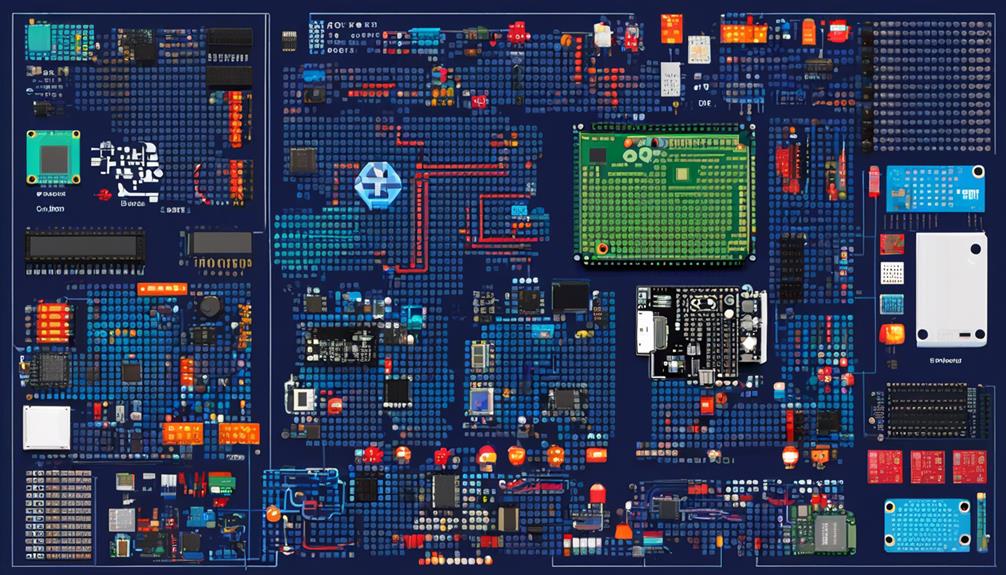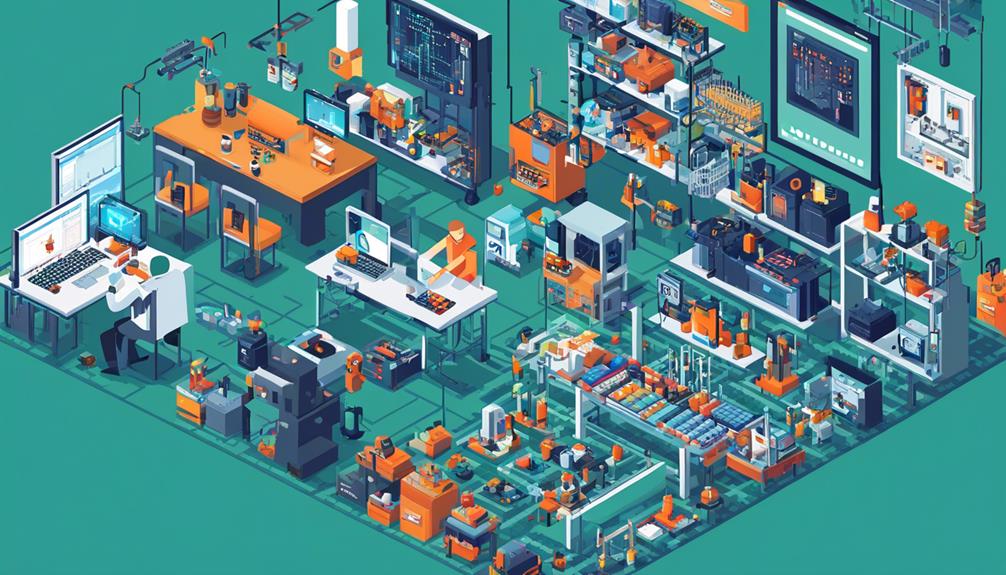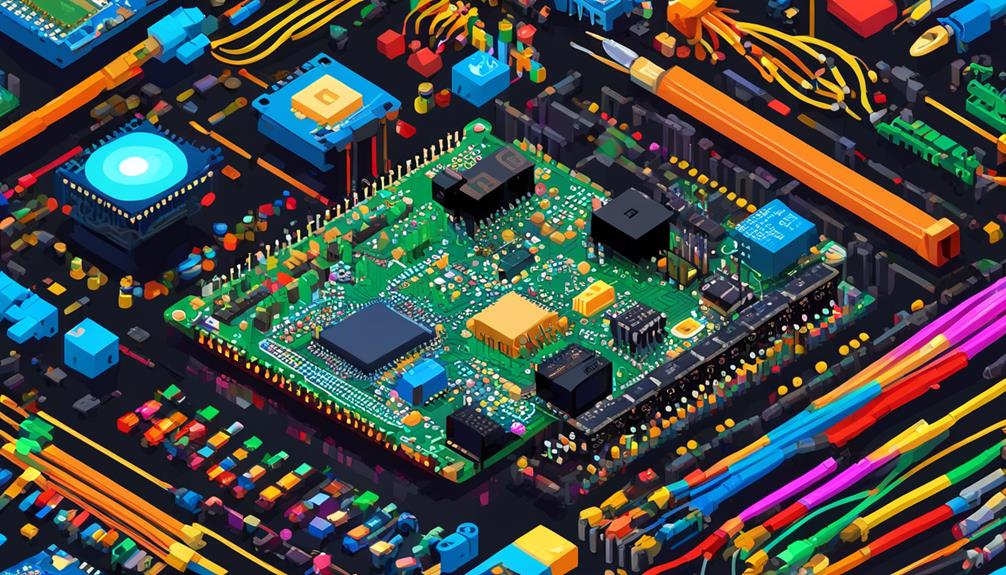In today's rapidly evolving technological landscape, the Internet of Things (IoT) has emerged as a powerful force, connecting devices and enabling seamless communication between them. As the demand for IoT solutions continues to grow, the need for efficient and user-friendly hardware development kits becomes increasingly important.
These kits serve as comprehensive solutions, providing the necessary tools to prototype, develop, and integrate IoT devices with cloud-based servers. With a wide range of features, such as network controllers and secure boot mechanisms, these kits simplify the process of connecting products to the IoT.
However, with numerous options available in the market, choosing the right IoT hardware development kit can be a daunting task. This discussion will explore key features of IoT hardware, popular development kits, factors to consider when making a choice, and tips for ensuring quality and reliability.
So, let's embark on this journey of exploring the world of IoT hardware development kits and uncover the best solutions for your IoT projects.
Key Takeaways
- IoT development kits offer easy connection to cloud-based servers, providing a seamless integration with cloud platforms.
- These kits provide all-in-one solutions for prototyping and development, making it convenient for developers to create IoT applications.
- Network controllers included in the kits enable simple and effective connection to popular cloud platforms like AWS.
- IoT development kits prioritize security with features like secure boot and firmware update mechanisms, ensuring the safety of the devices and data.
Key IoT Hardware Features

Key IoT hardware features include:
- Easy connection to cloud-based servers
- All-in-one solutions for prototyping and development
- A network controller for simple and effective connection to the AWS cloud platform, with support provided at every step.
IoT development kits are designed to simplify the process of developing and prototyping Internet of Things (IoT) applications. These kits provide the necessary hardware and software components to quickly connect devices to the cloud and start collecting and analyzing data.
One of the key features of IoT development kits is their ability to connect to cloud-based servers. This allows developers to easily integrate their devices with cloud platforms, such as the AWS cloud platform, for seamless data storage and analysis. By leveraging cloud-based servers, developers can take advantage of the scalability and flexibility offered by these platforms, enabling them to handle large amounts of data and scale their applications as needed.
Additionally, IoT development kits serve as all-in-one solutions for prototyping and development. They include all the necessary hardware and software components to rapidly build and test IoT applications. This eliminates the need for developers to source individual components and ensures compatibility between different components, saving time and effort in the development process.
Furthermore, IoT development kits often feature a network controller that enables a simple and effective connection to the AWS cloud platform. This controller ensures a reliable and secure connection, allowing devices to communicate with the cloud seamlessly. Support is also provided at every step of the development process, ensuring that developers have the necessary resources and assistance to overcome any challenges they may encounter.
Popular IoT Development Kits
When it comes to popular IoT development kits, there are several options to consider. These kits offer a range of key features such as easy connection to cloud-based servers, support for AWS platform, customization of web pages and network applications, and high-performance ARM processors with integrated Wi-Fi and Bluetooth.
Each kit has its own pros and cons, and understanding these features can help developers make an informed decision when choosing the right IoT development kit for their project.
Top IoT Kits
IoT development kits are widely recognized as essential tools for easily connecting to cloud-based servers and providing comprehensive solutions for prototyping and development. When it comes to the top IoT kits available in the market, there are a few notable options to consider:
- NetBurner System on Module (SOM) Development Kits: These kits offer the necessary hardware and software for customization, including an Eclipse-Based IDE (NBEclipse), example source code, and software libraries.
- ARM Embedded IoT Development Kit SOMRT1061: This kit stands out with its high-performance ARM processor, integrated Wi-Fi and Bluetooth, multiple GPIO pins, and onboard memory.
- Qorvo GaN Technology: Qorvo's GaN technology provides enhanced power efficiency and reliability for advanced RF and power devices, making it an excellent choice for IoT applications.
These top IoT kits offer a range of features and capabilities that enable developers to create innovative and efficient IoT solutions.
Key Features
With their comprehensive hardware and software offerings, IoT development kits provide developers with the necessary tools for seamless connectivity to cloud-based servers, facilitating prototyping and development processes.
Network controllers ensure simple and effective connection to cloud platforms like AWS, offering support at every step.
System on Module (SOM) Development Kits from NetBurner come equipped with all the required hardware and software, including an Eclipse-Based IDE, example source code, and software libraries.
The high-performance ARM processor IoT Development Kit SOMRT1061 features integrated Wi-Fi and Bluetooth for wireless connectivity and supports various operating systems, allowing flexibility in development.
Furthermore, IoT development kits also prioritize security, with features such as secure boot and firmware update mechanisms, encryption algorithms, and authentication protocols ensuring secure data transmission and storage for the Internet of Things.
Pros and Cons
One important aspect to consider when evaluating popular IoT development kits are their pros and cons.
These kits offer several advantages for developers, including:
- Easy connection to cloud-based servers
- All-in-one solutions with hardware and software
- Technical support
- Integrated debugging interfaces
For example, the ARM Embedded IoT Development Kit SOMRT1061 provides:
- A high-performance ARM processor
- Integrated Wi-Fi and Bluetooth
- Onboard memory for data storage and processing
However, there are also some drawbacks to consider. These include:
- Limitations in flexibility and customization
- Steep learning curve for beginners
- Hardware or software limitations that may impact scalability and performance
- Cost can be a limiting factor for developers with limited budgets
It is important to carefully evaluate these pros and cons when selecting an IoT development kit.
Factors to Consider When Choosing Iot Hardware
When selecting IoT hardware, it is crucial to consider factors such as compatibility with cloud platforms, security features, connectivity options, scalability, and development support. These factors will significantly impact the success and efficiency of your IoT project. Let's delve into each of these factors in detail:
- Compatibility with Cloud Platforms: Ensure that the IoT hardware you choose is compatible with the specific cloud platform you intend to use for data storage and analysis. This compatibility will enable seamless integration and efficient data transfer between the hardware and the cloud platform.
- Security Features: Security is of utmost importance in IoT applications. Look for hardware that offers robust security measures such as encryption, authentication protocols, and secure communication channels. These features will protect your data from unauthorized access and ensure the integrity of your IoT ecosystem.
- Connectivity Options: Consider the available wireless connectivity options offered by the hardware, such as Wi-Fi, Bluetooth, and cellular networks. Select the connectivity option that best aligns with your IoT application's requirements in terms of range, bandwidth, power consumption, and compatibility with existing infrastructure.
- Scalability: As your IoT deployment grows, it is essential to have hardware that can scale to accommodate the increasing number of connected devices and data volume. Choose hardware that can handle the anticipated growth without compromising performance or stability.
- Development Support: Evaluate the availability of software development tools, libraries, and technical support provided by the hardware manufacturer. These resources will streamline the prototyping and development process, enabling you to bring your IoT solution to market faster.
Consider these factors carefully when choosing IoT hardware to ensure that it aligns with your project's specific needs and requirements. The table below summarizes these factors for easy reference:
| Factors | Considerations |
|---|---|
| Compatibility with Cloud Platforms | Ensure seamless integration with the specific cloud platform used for data storage and analysis. |
| Security Features | Look for robust security measures such as encryption, authentication protocols, and secure communication channels. |
| Connectivity Options | Evaluate available wireless connectivity options (Wi-Fi, Bluetooth, cellular networks) based on range, bandwidth, power consumption, etc. |
| Scalability | Choose hardware that can scale to accommodate future growth in the number of connected devices and data volume. |
| Development Support | Assess the availability of software development tools, libraries, and technical support provided by the hardware manufacturer. |
Best IoT Hardware for Prototyping

In the realm of IoT hardware selection, finding the best options for prototyping requires careful consideration and evaluation of available development kits that offer comprehensive solutions for seamless integration and efficient development.
Here are some of the best IoT hardware development kits for prototyping:
- NetBurner System on Module (SOM) Development Kits: NetBurner offers a range of development kits that provide both hardware and software for customization. Their IoT Development Software includes an Eclipse-Based IDE (NBEclipse), example source code, and security and optional software modules. These kits make it easier to connect to cloud-based servers and provide all-in-one solutions for prototyping and development.
- ARM Embedded IoT Development Kit SOMRT1061: This development kit features a high-performance ARM processor, integrated Wi-Fi and Bluetooth, and support for various operating systems. It offers a robust solution for prototyping IoT projects, with its powerful hardware capabilities and flexibility.
- T-Mobile DevEdge IoT Developer Kit: This kit offers features such as automatic connection to the T-Mobile network, open software and hardware, and integrated Bluetooth and Wi-Fi capabilities. It provides a user-friendly and versatile platform for prototyping IoT applications.
- Other Development Kits: Apart from the mentioned kits, there are various other options available in the market, such as Raspberry Pi IoT Starter Kits, Arduino IoT Kits, and Intel Edison IoT Kits. These kits offer different features and capabilities, allowing developers to choose the one that best suits their prototyping needs.
When selecting the best IoT hardware for prototyping, it is important to consider factors such as the specific requirements of the project, ease of use, available resources and support, and scalability. By carefully evaluating these development kits, developers can make informed decisions and successfully prototype their IoT projects.
IoT Hardware for Testing Applications
When it comes to testing IoT hardware, one of the main considerations is application compatibility.
IoT hardware development kits like NetBurner's SOM Development Kits and the ARM Embedded IoT Development Kit SOMRT1061 offer the necessary features and capabilities for testing applications.
With integrated Wi-Fi, Bluetooth, GPIO pins, and onboard memory, these kits provide the tools needed to ensure that applications are compatible and function properly on IoT devices.
Testing IoT Hardware
Testing IoT hardware involves rigorous evaluation of its performance, connectivity, and security features to ensure seamless operation in real-world applications.
To achieve this, several test scenarios are conducted, including stress testing, interoperability testing, and compliance testing.
These tests validate the hardware's capabilities, reliability, power consumption, data transmission efficiency, and compatibility with different network protocols and cloud platforms.
Additionally, comprehensive testing helps identify and address potential vulnerabilities, ensuring the hardware's resilience against cyber threats and unauthorized access.
Given that IoT hardware operates within embedded systems, it is crucial to conduct thorough testing and validation to ensure consistent and secure performance in diverse IoT environments.
Application Compatibility
Application compatibility is a crucial aspect of IoT hardware development kits. These kits are designed to provide all-in-one solutions for prototyping and development, ensuring seamless integration and functionality for testing a wide range of applications. They enable easy connection to cloud-based servers, featuring network controllers that facilitate simple and effective connection to popular cloud platforms like AWS.
The included IoT development software offers a range of tools, including an Eclipse-based IDE, example source code, and security modules. Technical support is readily available throughout the development process, with options such as e-mail, online support portals, and a dedicated support forum for hardware and software discussions.
With application compatibility as a priority, these development kits provide the necessary resources for developers to test and validate their IoT applications effectively.
Iot Hardware With Strong Technical Support

IoT hardware with strong technical support ensures a seamless and efficient development process, providing comprehensive assistance at every stage. Developers can rely on these kits to overcome challenges and accelerate their IoT projects.
Here are four key benefits of IoT hardware with strong technical support:
- Easy Connection to Cloud-Based Servers: IoT development kits offer simple and effective connectivity to cloud platforms like AWS. This enables developers to easily integrate their devices with cloud services for data storage, analytics, and remote management.
- All-in-One Solutions for Prototyping and Development: These kits provide everything developers need to quickly prototype and build IoT solutions. From network controllers to sensors and actuators, they offer a comprehensive set of components for rapid development.
- Commitment to Partnering and Success: IoT hardware with strong technical support ensures a commitment to partnering with developers. They provide guidance, resources, and expertise to help developers overcome challenges and achieve success in their projects.
- Advanced Features and Capabilities: Leading IoT development kits, such as the ARM Embedded IoT Development Kit SOMRT1061 and the T-Mobile DevEdge IoT Developer Kit, offer advanced features like high-performance processors, integrated wireless connectivity (Wi-Fi and Bluetooth), and onboard memory for data storage and processing. These features enable developers to create sophisticated IoT solutions.
Ensuring Quality and Reliability in IoT Hardware
To ensure the seamless and secure connectivity of IoT hardware, it is imperative to prioritize quality and reliability through rigorous testing, compliance with industry standards, continuous monitoring, and collaboration with trusted suppliers and partners.
Quality and reliability are crucial aspects of IoT hardware development, as they directly impact the performance, security, and longevity of the devices.
To ensure the highest quality and reliability, IoT hardware undergoes rigorous testing and certification processes. This involves subjecting the hardware to various stress tests, including temperature, humidity, and vibration tests, to ensure that it can withstand harsh environmental conditions. Additionally, performance tests are conducted to verify that the hardware meets the specified requirements and performs optimally.
Compliance with industry regulations and standards is another fundamental aspect of ensuring quality and reliability in IoT hardware. Adhering to standards such as ISO 9001 and ISO 27001 ensures that the hardware is developed and manufactured following best practices. Compliance also includes meeting regulatory requirements related to data privacy and security, such as the General Data Protection Regulation (GDPR).
Continuous monitoring is essential to maintain the quality and reliability of IoT hardware throughout its lifecycle. This involves monitoring the performance of the hardware, collecting data on its usage, and identifying any potential issues or vulnerabilities. Regular software updates and patches are also crucial to address any security vulnerabilities and ensure that the hardware remains up-to-date and protected against emerging threats.
Collaboration with trusted suppliers and partners is vital to ensure the quality and reliability of IoT hardware components. Working closely with suppliers helps to ensure that the components used in the hardware meet the required quality standards. Additionally, partnering with trusted manufacturers and service providers ensures that the hardware is developed and maintained by experienced professionals who prioritize quality and reliability.
Frequently Asked Questions
What Is an Iot Developer Kit?
An IoT developer kit is a comprehensive solution that provides developers with the necessary tools and resources to create applications for the Internet of Things (IoT).
These kits typically include software development tools, documentation, and support to assist developers in building and deploying IoT applications.
They enable developers to gain the necessary skills and knowledge required to design, develop, and deploy IoT solutions.
What Are Iot Kits?
IoT kits are comprehensive packages that facilitate the development and prototyping of Internet of Things (IoT) projects. They include all the necessary components, such as development boards, network controllers, and software libraries, to enable easy connectivity to cloud-based platforms like AWS.
These kits are designed to be compatible with various IoT hardware devices, allowing developers to quickly and effectively connect and interact with them. They also provide technical support and documentation to assist users throughout their development process.
What Is Iot Hardware Platform?
An IoT hardware platform refers to the underlying infrastructure and components used for building and deploying IoT devices. It encompasses the physical hardware, such as sensors, actuators, and microcontrollers, as well as the software and firmware necessary to control and manage these devices.
The platform provides a framework for connecting, collecting, and analyzing data from IoT devices, enabling seamless integration with cloud-based services and applications. Challenges in IoT hardware integration may include compatibility issues, power management, security, and scalability.
What Is Iot Software Development?
IoT software development refers to the process of creating and programming applications and systems that enable devices to connect, communicate, and exchange data within the Internet of Things ecosystem.
It involves developing software that facilitates data collection, analysis, and utilization from interconnected IoT devices, enabling automation, monitoring, and control of various processes.
IoT software development also includes implementing security measures such as encryption, authentication, access control, and intrusion detection to protect IoT data and devices from unauthorized access and cyber threats.

